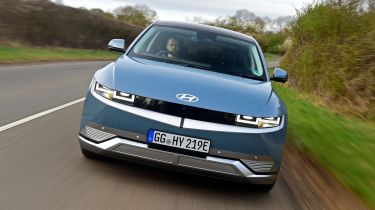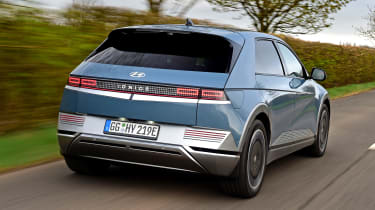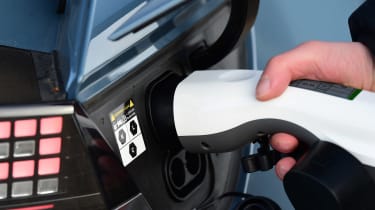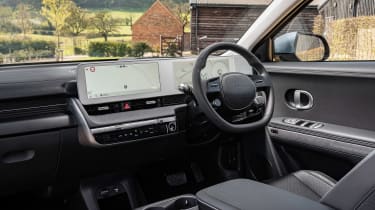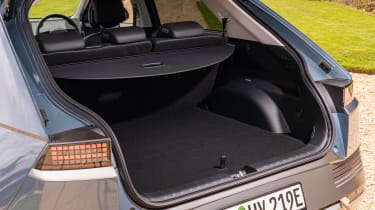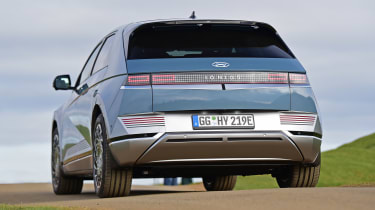2021 Hyundai Ioniq 5: full pricing, specifications and prototype driven
Retro-styled electric crossover launches Hyundai’s Ioniq EV brand and we've driven a development car
- Available now from £36,995
- SE Connect, Premium and Ultimate trim levels
- 80% battery top-up in 18 minutes
Pricing for the Hyundai Ioniq 5 has been announced, with the new electric car available to order now for a starting price of £36,995. Rather than having any direct links to the existing Hyundai Ioniq, the Ioniq name is becoming a sub-brand that will only offer electric cars.
 The 10 best electric cars in 2025
The 10 best electric cars in 2025
It will be offered in a variety of configurations, with a choice of two battery sizes, three power outputs and either rear or four-wheel drive. For the starting price, buyers will get a 58kWh battery and a single motor with 168bhp and a range of 240 miles. The Ioniq 5 doesn’t qualify for the Plug-in Car Grant (PiGC), as it now only applies to zero-emissions vehicles costing £35,000 or less.
The 73kWh battery Ioniq 5 with 215bhp will cost from £41,945 and get a range of up to 300 miles, while upgrading to four-wheel drive increases power to 301bhp but reduces range to 287 miles and bumps up the price to £45,145.
Since its reveal on 23 February, the Ioniq 5 has received the highest number of enquiries for any Hyundai model in the brand's history. A special edition Ioniq 5 Project 45 limited to 3,000 examples was sold out within hours.
Before the Ioniq 5 arrives in showrooms, we've driven a prototype to see what we can expect. Read on for our review of Hyundai’s rival to the Volkswagen ID.4.
Despite its compact appearance, the Ioniq 5 is actually longer than the new Hyundai Tucson, and its long wheelbase will be good for passenger space. The 5 will rival a wide range of models, including hatchbacks like the Tesla Model 3 and Volkswagen ID.3 to SUVs like the Nissan Ariya and Ford Mustang Mach-E. It sits slightly higher than a conventional hatchback like the Ford Focus, due to the positioning of the batteries under the floor, so Hyundai calls it a crossover.
Hyundai has confirmed a ‘Project 45’ first edition model. Buyers of this model will get notifications such as when the car leaves the factory, and the Project 45 also gets a free two-year subscription to chargepoint provider Ionity.
Hyundai Ioniq 5 performance
The Ioniq 5 is available with a choice of 58 or 73kWh batteries, and both come with either rear or all-wheel drive. Picking the bigger battery also means you get a more powerful rear motor, and these versions are about a second quicker from 0-62mph than the 58kWh battery options. The fastest version is the AWD model with the bigger battery, which gets from 0-62mph in just 5.2 seconds, while the 58kWh RWD version takes 8.5 seconds. All top out at 115mph.
It’s the first car to be built on the Hyundai Group’s brand-new scalable electric car platform, called E-GMP, which will soon underpin many more Hyundai and Kia electric vehicles.
Range and charging
Hyundai states that the 73kWh battery option manages up to 300 miles between charges with rear-wheel drive, decreasing slightly to 287 miles in four-wheel-drive versions. The smaller 58kWh battery delivers a range of up to 240 miles.
There’s 800-volt battery technology, like you get with the Porsche Taycan, which means the Ioniq 5 can recharge to 80% in just 18 minutes and a five-minute charge can add 62 miles of range. Fully charging the 58kWh battery pack using a 10.5kW home wallbox should take five hours, increasing just just over six hours for the 73kWh battery.
If you can only find a 50kW public charger, an 80% charge will take around 46 minutes for the smaller battery and just under an hour for the 73kWh version.
It will also be possible to use suitably equipped versions of the Ioniq 5 as a power source. Hyundai has released videos showing someone cooking a turkey, listening to music and exercising on a treadmill using power from the car.
Styling
In many respects, the final production model of the Ioniq 5 looks very similar to the Hyundai 45 concept, which was inspired by the 1974 Hyundai Pony Coupe. The square headlights and wide, slim grille feature on this model, as do the similarly boxy tail-lights. The silhouette is close to the original design, too, and the intricate alloy wheels look to have been carried over. They’ll be 20 inches in diameter on production cars and the largest ones fitted to an electric Hyundai.
The Ioniq 5 also gets a clamshell bonnet (another first for Hyundai), flush door handles and active air intakes in the front bumper. Where a grille would be on petrol and diesel versions, Hyundai has fitted all the sensors for the driver assistance features. Five of the nine paint colours offered are new.
Interior and technology
Fittingly for a car that produces no local emissions, the Ioniq 5’s interior features a number of sustainable materials, including upholstery made from recycled plastic bottles, paint derived from vegetable oil and door trims finished in ‘paperette’. We’re told this is a fully recyclable material that feels like paper.
The touchscreen and digital instrument cluster both measure 12.25 inches and form part of the new car’s impressive technology repertoire. There’s an ‘augmented reality’ head-up display that projects important information onto the windscreen ahead of the driver, plus advanced voice recognition software and wireless phone charging. Apple CarPlay and Android Auto are also fitted if you want to use your phone’s apps. Via Hyundai’s app, you can see charging progress, personalise user profiles and get live traffic updates.
Hyundai’s SmartSense package is also included, although it remains to be seen how much will be standard. Safety features include highway driving assist with lane-changing capability, speed limit assistance and evasive steering assist. Like the new Tucson, Hyundai has also added in a warning that comes up if the car thinks you’ve left people in the back seats when you get out.
Trim levels and equipment
The Hyundai Ioniq 5 will be available in three trims, SE Connect, Premium and Ultimate, along with the launch special edition Project 45. SE Connect is well stocked, with 19-inch alloy wheels, cloth upholstery from 'naturally derived polyester resin', a 12.3-inch infotainment display with sat nav, Apple CarPlay and Android Auto, digital instruments, wireless phone charging, a rear-view camera and LED exterior lighting.
Premium adds a powered driver's seat along with front seat heating, LED projector headlights, a powered boot and chrome exterior trim. It also makes the optional 'Vehicle 2 Load' (V2L) pack available, which makes it possible to power or charge external devices using the car as an electricity source.
Only available with the larger battery, Ultimate spec includes 20-inch alloy wheels, leather upholstery, privacy glass, black exterior trim, electrically adjustable and ventilated front seats, heated rear seats, a Bose sound system, a head-up display with augmented reality, alloy pedals and a sliding centre console. V2L is also fitted as standard. Buyers can also choose the optional Eco Pack, which adds systems to heat up the battery and a heat pump, improving the efficiency of the electric powertrain.
Safety equipment is also affected by the trim chosen, with SE Connect getting adaptive cruise control and lane keep assist, while Premium adds Highway Drive Assist Level 2, which enables the car to change lanes autonomously. Blind-spot and junction collision avoidance systems are also added. Ultimate models with a Tech Pack adds more safety tech in the form of parking collision avoidance, remote self-parking and a surround view monitor.
Practicality
The rear seats can slide forwards and backwards so you can prioritise passenger space or luggage capacity, of which there’s 527 litres. Fold the rear seats down and space increases to 1,587 litres, while there’s an additional storage space under the bonnet because most of the parts are contained under the floor. This measures 57 litres in rear-wheel drive versions, shrinking to 24 litres when four-wheel drive is fitted.
2021 Ioniq 5 prototype drive by Alex Ingram
Hyundai was keen to point out that the suspension, motor calibration and refinement weren't at the level of a final production model, but that didn't stop us being excited to try out a pre-production Ioniq 5.
Even in this form, we found plenty to appreciate. Most striking was the ride comfort, which was noticeably more relaxed than the Hyundai Kona Electric; a car that's been criticised somewhat for its slightly jittery ride. A long wheelbase (the distance between the front and rear wheels) and clever multi-link suspension has clearly paid off.
Despite this softer setup, the Ioniq 5's square, athletic stance and low centre of gravity also means it doesn't lean too much in corners. While we weren't able to push the prototype vehicle too hard, body roll was less pronounced than you expect given the car’s supple ride.
Poise and stability are important for this range-topping model because it features two electric motors with a combined 302bhp. Performance felt just as strong as its official 5.2-second 0-62mph time suggests, yet when you aren't accelerating hard, the Ioniq 5 reverts to rear-wheel drive to maximise range. By conserving energy, it should be able to do around 300 miles between charges, thanks to a 73kWh battery.
Most buyers will likely be satisfied with the 168bhp entry-level model, which is fitted with a 58kWh battery. Thanks to an 800-volt electrical architecture, it will be able to charge at up to 220kW, which is faster than most rivals. Find a potent enough charging station and it's possible to add around 62 miles of range in five minutes.
The dashboard is dominated by a pair of screens and, while they aren't quite as sharp or responsive as in a Tesla, they look good and function well. If anything, the design is too minimalist, with almost no branding and just four squares embossed on the steering wheel.
There’s plenty of space thanks to a flat floor that gives the Ioniq 5 lots of legroom. It also has a neat party trick - the front seats can electrically fold almost completely flat, making it possible to take a nap or load particularly long items into the passenger-side of the interior. A 527-litre boot will be competitive with other SUVs while giving it a useful advantage over a Golf-sized family hatchback.
Verdict
First impressions are very promising, thanks to the Ioniq 5's impressive performance, plush ride and long range. Its interior is also very modern and spacious but we are expecting the Ioniq 5 to be more expensive than the Volkswagen ID.4.
Read about the company’s current Hyundai Kona Electric and Hyundai Ioniq Electric models here, or see where they feature on our list of the best electric cars to buy now.
Recommended

New Subaru Trailseeker revealed as rugged electric SUV with 375bhp

New Subaru Solterra brings more range, power and polish
Most Popular
Tips & advice

Car dashboard warning lights: what does each symbol mean?

Electric car charging stations: public networks, charger types, apps and maps


